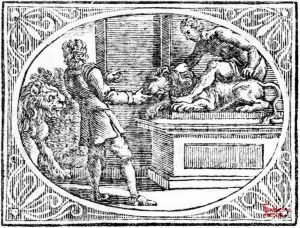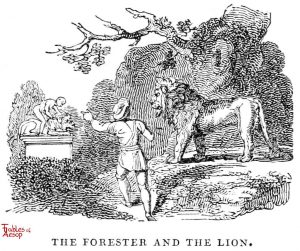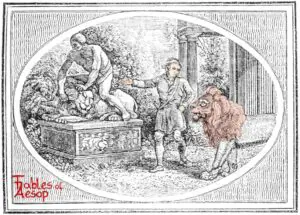A Lion sees a statue of Man defeating a Lion and comments that had a Lion carved the statue it would be different.
Truth is in the eye of the story teller.

Eliot/Jacobs Version
A Man and a Lion were discussing the relative strength of men and lions. The Man contended he and his fellows were stronger than lions by reason of their greater intelligence.
“Come now with me and I will prove that I am right.”
He took the Lion into the public gardens and showed him a statue of Hercules overcoming a Lion. “That is all very well,” said the Lion, “but proves nothing, for it was a man who made the statue. If a Lion had made it, the Man would be under a Lion’s paw.”

Samuel Croxall (The Forester and the Lion)
THE Forester meeting with a Lion, one day, they discoursed together for a while without differing much in opinion. At last, a dispute happening to arise about the point of superiority between a man and a Lion; the man, wanting a better argument, showed the Lion a marble monument, on which was placed the statue of a man striding over a vanquished Lion. If this, says the Lion, is all you have to say for it, let us be the carvers, and we will make the Lion striding over the Man.
THE APPLICATION
Contending parties are very apt to appeal for the truth to records written by their own side; but nothing is more unfair, and at the same time insignificant and unconvincing. Such is the partiality of mankind in favour of themselves and their own actions, that it is almost impossible to come at any certainty by reading the accounts which are written on one side only. We have few or no memoirs come down to us of what was transacted in the world during the sovereignty of ancient Rome, but what were written by those who had a dependency upon it; therefore it is no wonder that they appear, upon most occasions, to have been so great and glorious a nation. What their contemporaries of other countries thought of them we cannot tell, otherwise than from their own writers: it is not impossible but they might have described them as a barbarous, rapacious, treacherous, unpolite people; who, upon their conquest of Greece, for some time, made as great havoc and destruction of the arts and sciences, as their fellow plunderers, the Goths and Vandals did, afterwards, in Italy. What monsters would our own party-zealots make of each other, if the transactions of the times were to be handed down to posterity by a warm hearty man on either side! And were such records to survive two or three centuries, with what perplexities and difficulties must they embarrass a young historian, as by turns he consulted them for the characters of his great forefathers! If it should so happen, it were to be wished this application might be living at the same time; that young readers, instead of doubting to which they should give credit, would not fail to remember, that this was the work of a man, that of a lion.

Thomas Bewick (The Forester and The Lion)
The Forester meeting with the Lion one day, they discoursed together for a while without much differing in opinion. At last, a dispute happening to arise about the point of superiority between a Man and a Lion, the former wanting a better argument, shewed the latter a marble monument, on which was placed the statue of a Man striding over a vanquished Lion. If this, says the Lion, is all you have to say for it, let us be the sculptors, and we will make the Lion striding over the Man.
APPLICATION.
Such is the partiality of mankind in favour of themselves and their own actions, that it is extremely difficult, nay almost impossible to come at any certainty, by reading the accounts that are written on one side only. The simple truth is still perverted, as prejudice, vanity, or interest warps the mind, and it is not discovered in all its brilliancy, till the mists which obscure it are swept away by the most rigid investigation. In what an odious light would our party men place each other, if the transactions of the times were handed down to posterity by a warm zealot on either side; and were such records to survive a few centuries, with what perplexities and difficulties would they embarrass the historian, as by turns he consulted them for the character of his great forefathers. The same difficulties would occur in writing the history of nations, both ancient and modern. Some of those who flourish at this day, and consider themselves as having reached perfection in civilization and polished manners, will perhaps, not unjustly, be branded in after-times with cruelty, injustice, and oppression, in having confounded all simplicity of manners, and disturbed the peace of whole nations, by carrying the horrors of war, of murder, and desolation, into regions formerly blessed with uninterrupted tranquillity.
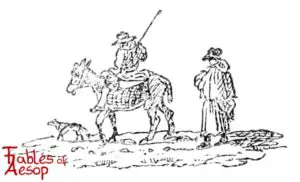

Aesop For Children (The Man and The Lion)
A Lion and a Man chanced to travel in company through the forest. They soon began to quarrel, for each of them boasted that he and his kind were far superior to the other both in strength and mind.
Now they reached a clearing in the forest and there stood a statue. It was a representation of Heracles in the act of tearing the jaws of the Nemean Lion.
“See,” said the man, “that’s how strong we are! The King of Beasts is like wax in our hands!”
“Ho!” laughed the Lion, “a Man made that statue. It would have been quite a different scene had a Lion made it!”
Moral
It all depends on the point of view, and who tells the story.

JBR Collection
A Man and a Lion once argued together as to which belonged to the nobler race. The former called the attention of the Lion to a monument on which was sculptured a Man striding over a vanquished Lion. “That proves nothing at all,” said the Lion; “if a Lion had been the carver, he would have made the Lion striding over the Man.”

Jefferys Taylor
A MAN and a lion once had a dispute,
Which was reckoned the greatest, the man or the brute,
The lion discoursed on his side at some length,
And greatly enlarged on his courage and strength.
The man, one would think, had enough to reply
On his side the question, which none could deny;
But, like many others who make a pretence,
He talk’d perfect nonsense and thought it was sense.
“So,” said he, “don’t be prating, look yonder, I pray,
At that sculpture of marble, now what will you say?”
The lion is vanquish’d; but, as for the man,
He is striding upon him; deny it who can.
“But pray,” said the lion, “who sculptured that stone?”
“One of us,” said the man, “I must cand’dly own;”
“But when we are sculptors,” the other replied
“You will then on the man see the lion astride.
The man might have added, if he had been wise,
“But a beast cannot sculpture a stone if he tries.”
That sufficiently shows where the difference lies.

Townsend version (The Man and The Lion)
A man and a Lion traveled together through the forest. They soon began to boast of their respective superiority to each other in strength and prowess. As they were disputing, they passed a statue carved in stone, which represented “a Lion strangled by a Man.” The traveler pointed to it and said: “See there! How strong we are, and how we prevail over even the king of beasts.” The Lion replied: “This statue was made by one of you men. If we Lions knew how to erect statues, you would see the Man placed under the paw of the Lion.”
Moral
One story is good, till another is told.

Crane Poetry Visual
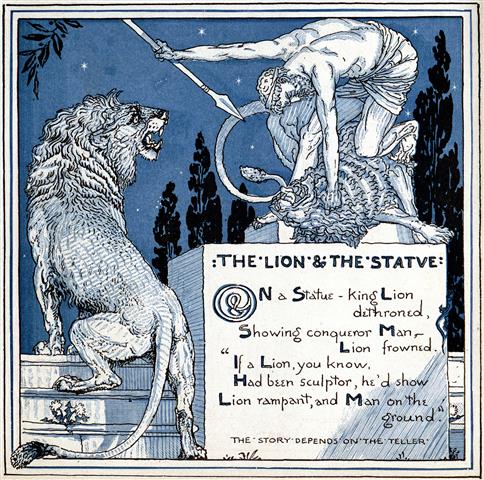
On a Statue – king Lion dethroned,
Showing conqueror Man … Lion frowned.
“If a Lion, you know,
Had been sculptor, he’d show
Lion rampart, and Man on the ground.”
The story depends on the teller.

Leo et Homo, Concertantes
Homo et leo inter se concertabant quis eorum esset superior et, cum venissent ut quaererent huius altercationis testimonium ad monumentum ubi erat pictura quomodo ab homine leo suffocaretur, ostendit leoni homo testimonium in pictura. Cui leo sic ait, “Hoc ab homine pictum est. Nam si leo pingere posset, pinxisset quomodo leo suffocasset hominem. Veni mecum et dabo tibi verum testimonium.” Deduxit leo hominem ad amphitheatrum, et ostendit illi veram fidem quomodo homo a leone suffocatur et dixit homini, “Hoc testimonium non est color, sed opus in veritate factum.”
Perry #284
